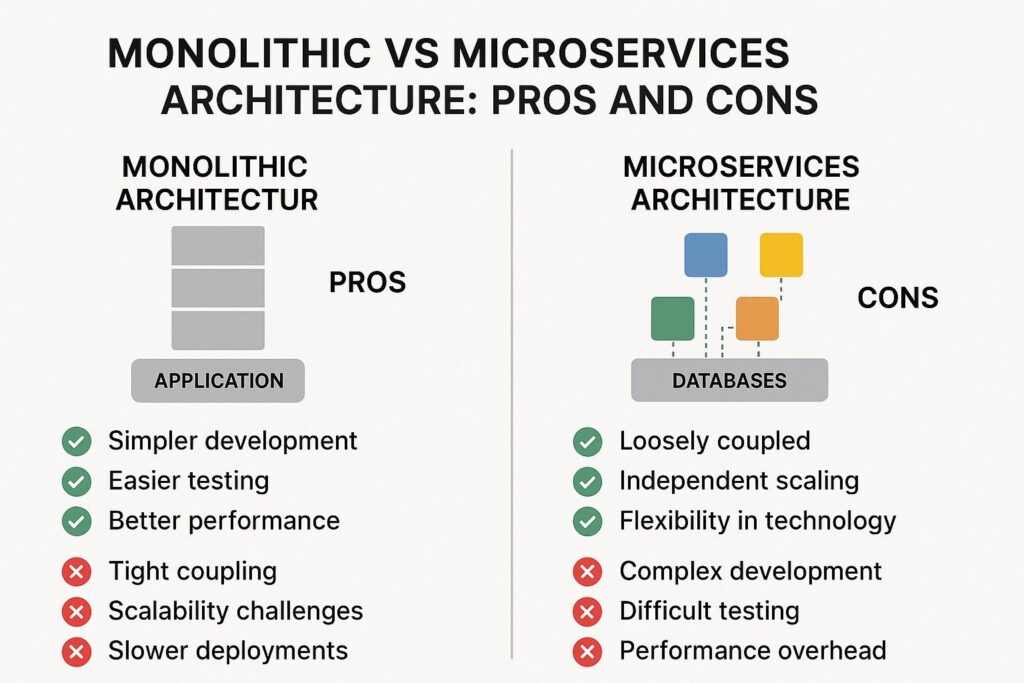
Choosing the right software architecture is a pivotal decision that affects every stage of an application’s lifecycle—from development and deployment to maintenance and scalability. Two of the most widely adopted architectural styles today are Monolithic Architecture and Microservices Architecture. Each comes with unique strengths and trade-offs, and understanding these differences can help you select the right fit for your project’s requirements, team structure, and long-term goals.
In this guide, we’ll examine both architectures in depth, covering their characteristics, benefits, challenges, and the scenarios where each shines.
What is Monolithic Architecture?
A monolithic architecture is a traditional software design pattern where all components of an application—user interface, business logic, and data access—are packaged into a single codebase and deployed as a single executable unit. Whether you’re adding a feature or fixing a bug, all changes are made within the same codebase and typically released together.
Core Characteristics:
- Single, unified codebase for the entire application.
- Single deployment artifact such as a
.war,.jar, or Docker image. - Tight coupling between internal components and layers.
- Shared runtime and memory, making intra-process communication fast and simple.
Common Use Cases:
- Early-stage startups looking to build an MVP quickly.
- Internal business tools with limited users.
- Web applications with minimal integration requirements.
- Projects with small development teams.
Monoliths are often the default choice when speed of delivery and simplicity of design are top priorities.
What is Microservices Architecture?
In a microservices architecture, an application is broken down into a set of smaller, loosely coupled, and independently deployable services. Each service is responsible for a specific business function and can be developed, deployed, scaled, and maintained independently. These services typically communicate over lightweight protocols like HTTP or messaging queues.
Core Characteristics:
- Multiple codebases, one per service.
- Independent deployment pipelines per service.
- Separation of concerns, with each microservice owning its own domain logic and often its own database.
- Teams can operate autonomously on different services using diverse technologies.
Common Use Cases:
- Large-scale enterprise systems.
- Applications with high availability and scalability requirements.
- Organizations practicing DevOps and Continuous Delivery.
- Platforms needing integration with multiple external services.
Microservices are ideal for modular, scalable systems and for companies that want to deploy features frequently with reduced interdependencies.
Monolithic vs Microservices: Feature-by-Feature Comparison
| Feature | Monolithic Architecture | Microservices Architecture |
|---|---|---|
| Codebase | Single repository | Multiple independent codebases |
| Deployment | One unit; entire app redeployed on change | Independent deployment per service |
| Scalability | Scales as a whole | Scales per service/component |
| Technology Stack | Usually uniform across app | Can vary by service |
| Testing | Easier for integrated testing | Requires mocking, contracts, and end-to-end tests |
| Fault Tolerance | One failure can crash the entire system | Failure isolated to individual services |
| DevOps Complexity | Relatively simple setup | High complexity with orchestration and monitoring |
| Database | Centralized (often one DB) | Decentralized; one DB per service (in many cases) |
| Team Structure | Works well for small, centralized teams | Aligns with cross-functional, distributed teams |
| Learning Curve | Easier for beginners | Steeper due to distributed nature |
Advantages and Disadvantages of Monolithic Architecture
Pros:
- Simplicity and Faster Development
With everything in one place, a monolithic architecture is easier to build and understand, particularly for small teams or junior developers. - Performance Efficiency
All calls between components are local, which reduces latency and boosts overall performance. - Easier Deployment and Testing
A single application package simplifies the deployment pipeline. QA teams can run integration and functional tests without dealing with service communication boundaries. - Streamlined Debugging and Logging
Logs are centralized, making it easier to trace bugs and analyze system behavior.
Cons:
- Scalability Challenges
Scaling the application requires deploying additional instances of the entire codebase, even if only one module is under load. - Reduced Agility
A change in one module often necessitates redeployment of the entire application, increasing risk and downtime. - Code Entanglement
As applications grow, maintaining clean modular separation becomes difficult. One tightly coupled module can introduce bugs across the entire system. - Limited Technology Flexibility
You’re generally locked into a single tech stack, making it hard to experiment with newer tools or frameworks.
Advantages and Disadvantages of Microservices Architecture
Pros:
- Independent Development and Deployment
Teams can work concurrently on different services and deploy changes without coordinating with other teams. - Improved Fault Isolation
A failure in one microservice (e.g., billing) doesn’t necessarily affect other services like authentication or product catalog. - Fine-Grained Scalability
Services can be scaled independently based on their own load profiles, which is more efficient and cost-effective. - Technology Agility
Teams can choose the right technology stack for each service, optimizing performance, maintainability, or development speed. - Optimized for DevOps
Enables CI/CD pipelines per service and supports automation in testing, deployment, and monitoring.
Cons:
- Operational Overhead
Managing hundreds of services requires a mature infrastructure setup—monitoring, centralized logging, API gateways, and service discovery. - Increased Complexity in Communication
Inter-service communication must be handled explicitly, which introduces latency, error handling, and serialization challenges. - Distributed Data Management
Maintaining consistency across services with their own databases (eventual consistency, replication, transactions) becomes complex. - Steeper Learning Curve
Requires knowledge of distributed systems, cloud infrastructure, containerization, and more—raising the bar for development teams.
When Should You Use Monolithic Architecture?
- You’re building an MVP and want to launch quickly with minimal overhead.
- Your application is simple and unlikely to grow into a massive, distributed platform.
- You want a straightforward deployment process.
- Your team is small, and coordination across microservices would slow down productivity.
- You have limited DevOps infrastructure or experience with CI/CD orchestration.
When Should You Use Microservices Architecture?
- Your product or platform is expected to scale rapidly or serve a large user base.
- You have multiple teams working on different business domains.
- You need to deploy features frequently with minimal impact on the entire system.
- You plan to use cloud-native infrastructure, container orchestration (Kubernetes), and service meshes.
- You’re building a modular system with distinct domains (e.g., billing, user management, analytics).
Final Thoughts
Choosing between monolithic and microservices architecture should not be based on trends or popularity—it should align with your business needs, team maturity, and operational readiness. Monoliths offer a fast and stable path to market with lower complexity, while microservices provide the agility and scalability necessary for large, modern applications.
Many successful organizations start with a monolith and gradually evolve into microservices once the product, user base, and team scale justify the shift. Whichever path you take, make sure your architecture supports maintainability, testability, and future growth.

I’m Shreyash Mhashilkar, an IT professional who loves building user-friendly, scalable digital solutions. Outside of coding, I enjoy researching new places, learning about different cultures, and exploring how technology shapes the way we live and travel. I share my experiences and discoveries to help others explore new places, cultures, and ideas with curiosity and enthusiasm.






